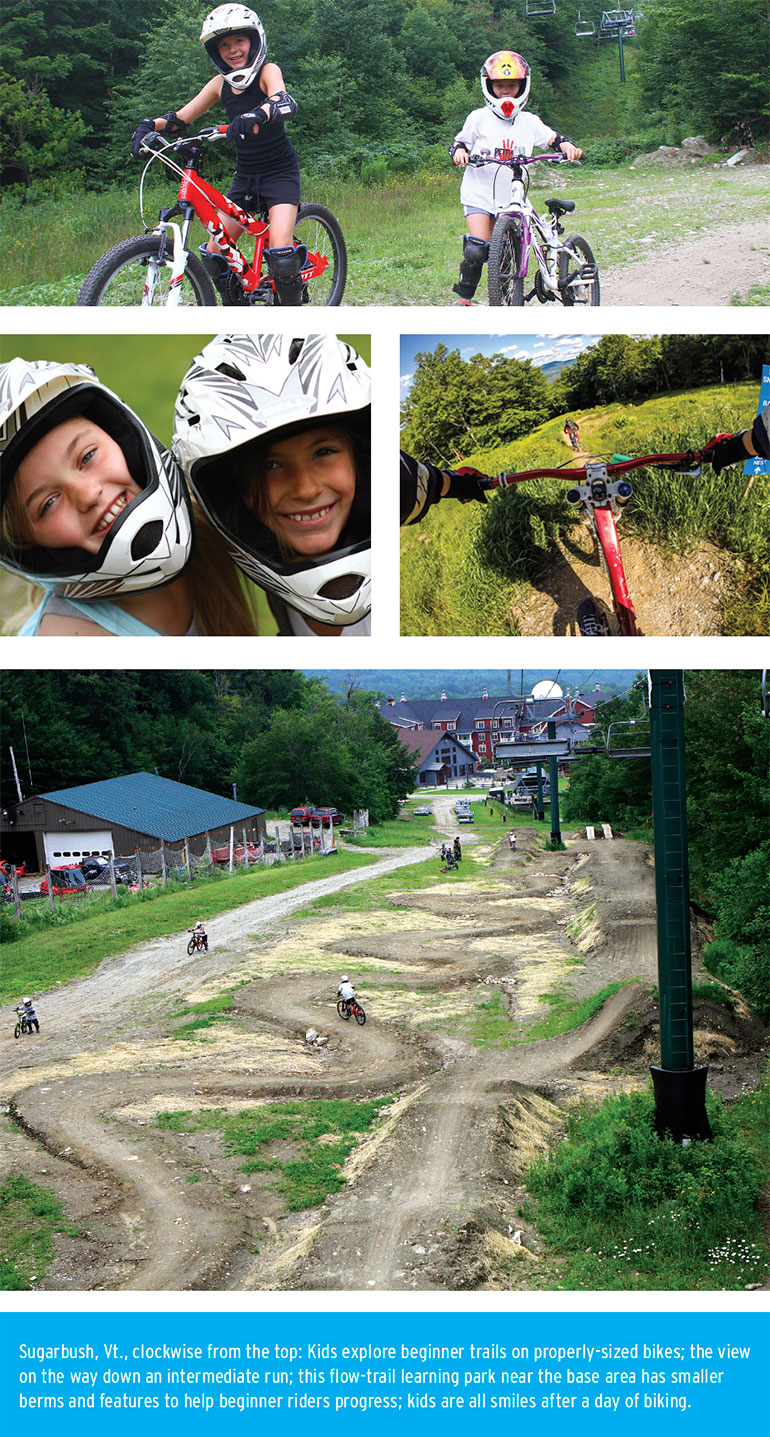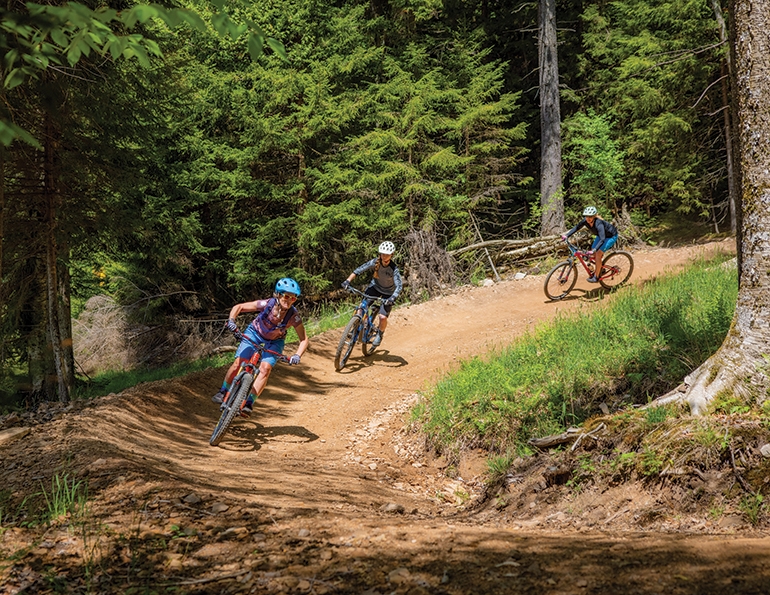Bike business is booming as families continue to turn to outdoor recreation, and ski areas primed to seize the moment have seen summer bike park activity snowball.
“We were already on a good growth trend before Covid, but things took off for us in 2020,” says Ken Gaitor, VP of mountain operations at Snowshoe, W.Va. “The timing lined up nicely with our momentum, as parents gained more flexibility around work and families leaned into the outdoor lifestyle.”
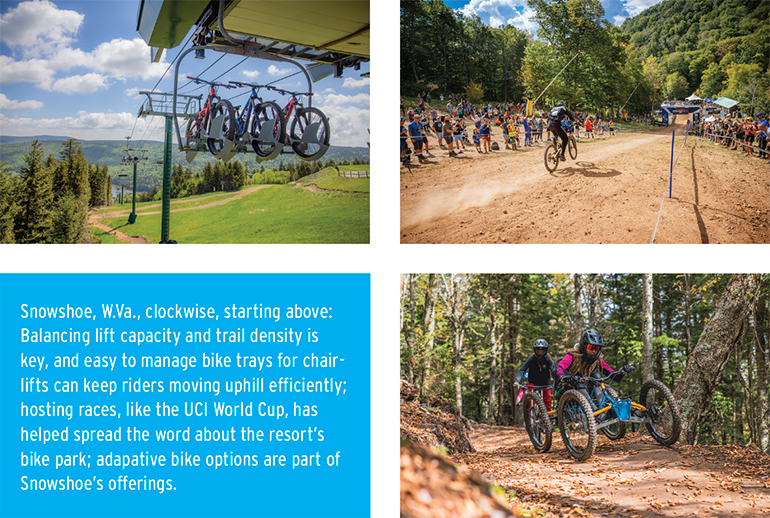
Snowshoe is not alone. “The last two seasons capped eight years of consecutive growth in bike park business for us,” says Hugh Reynolds, chief marketing officer of SNOW Partners, which owns Mountain Creek, N.J.
“Growth was phenomenal for those resorts who positioned themselves to capture it,” agrees Joey Carey, bike school manager at Killington, Vt., from 2019 through 2021. Carey is now at Sugarbush, Vt., where he says bike operations were up 30 percent last summer.
From professional-level experts to first timers to toddlers scooting around on balance bikes, riders of every skill level are coming out in record numbers. And, with beginner and intermediate riders starting to make up the bulk of bike park visits, those ski areas that can apply their winter learning and conversion tactics to summer dirt are poised to excel.
The Right Terrain
Dave Kelly, co-owner of trail building and consulting company Gravity Logic, helped create some of the first purpose-built downhill trails at Whistler Blackcomb, B.C. He says that his team realized early in the park’s development that its largely technical trail offerings catered only to the narrowest audience. “We’d see [guests] walking their bikes back down the trail, upset and unhappy with the experience,” says Kelly.
Once Kelly and his team added more smooth, wide trails that had a more moderate pitch, he noticed more riders biking in control and fewer leaving scared or intimidated. “The growth was immediate and obvious once we started putting in easier trails,” he says.
It’s true that building green and blue trails can be more time consuming and costly than building advanced trails.
“We’re always looking to expand beginner terrain, but it’s the hardest for us to build based on the natural geology and topography of our mountain,” says Reynolds. “We have a lot of rock, so it took a while for us to have a true top to bottom beginner trail.”
Still, resorts say it’s worth investing in an experience the whole family can enjoy both together and as individuals.
Learning areas. One of the biggest barriers to participation aside from money is fear, says Gaitor, something Snowshoe mitigates by building in opportunities for progression, much like with snow sliding. “Very small steps in progression in our park is key,” he says.
Creating an area designed to teach skills is also critical. “It’s hard to prepare someone for what they’re going to encounter on the mountain,” says Reynolds. “We built a new progression area that was a little more inclusive of some of the features you’d see—small berms and turns, and some small drops and jumps and depression areas that allow us to teach a higher-level lesson.”
Beginner Programming
Private lessons more than doubled at the Aspen Snowmass, Colo., bike park in 2020 and continued to climb in 2021, says Aspen Skiing Company bike school director Kevin Jordan. He attributes much of the “explosive” growth to lessons learned in ski school operations.
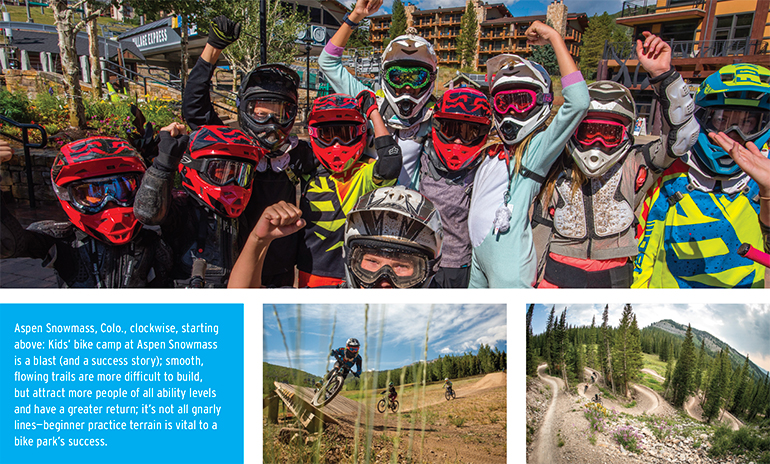
“No one really wants to take a bike lesson, because most people learn to ride a bike at an early age,” says Jordan. “So, we changed the semantics and call our instructors ‘coaches’ or ‘guides’ and invite [guests] to join a ‘clinic’ where we show them around and give them some tips.”
“Coaches” at Snowmass and other areas are often winter employees that have been upskilled or cross trained for the bike park. “If they have a background in teaching, their skill set can carry them into summer, and we train them in bike-specific instruction,” says Reynolds.
Product packaging. A lesson shortens the learning curve, improving the conversion rate. And, as in winter, aggressive pricing on products that package lessons and rentals together helps such offerings make financial sense for the guest.
“Our bike school offers a substantial discount to new riders where we outfit them completely if they sign up for a lesson,” says Gaitor. “We charge real money for the lesson but discount the rental and lift ticket.”
Gaitor says the biggest impact is made by offering the package cheap to get that first timer in a lesson, even if Snowshoe only breaks even on the first day. “The goal is to create a rider, and they’ll come back after having a good experience,” he says. “Maybe buy a bike from us and bring several friends.”
Capturing youth. To that end, discounted youth tickets are also helping drive participation. As a result of demand from that market, camp signups are surging.
“The demand for kids camps at Mountain Creek was so strong, we moved to the same model we use in winter—offering beginner and intermediate kids-specific lessons each weekend, so parents can put their kids in a lesson while they enjoy the park or take a lesson of their own,” says Reynolds.
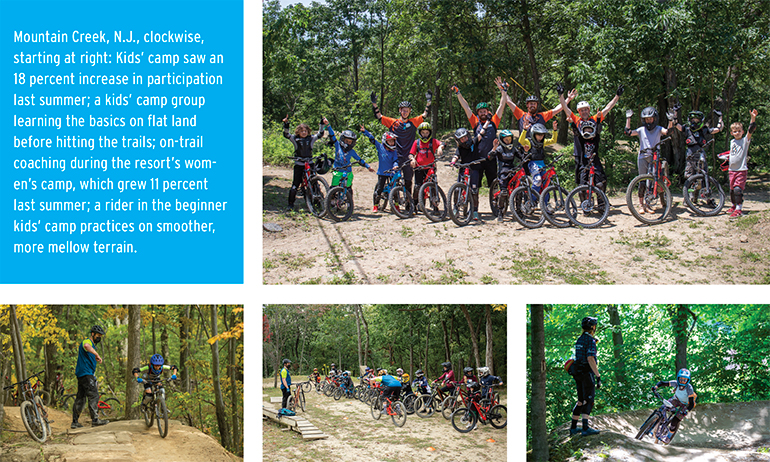
As a result, the resort saw an 18 percent increase in children’s camp participation last summer and an 11 percent increase in women’s camps, says Reynolds. “Female ridership is up to around 25 percent. In ski, that’s closer to 40 percent, so there is still a lot of room for growth,” he notes.
Rental Gear
While people trying downhill for the first time often know how to ride a bike, most do not arrive with the necessary specialized gear. Bicycle technology has come a long way in recent years. A downhill bike, with longer geometry and full suspension, assures a smoother ride and better traction, so maintaining a fleet of downhill rentals, along with protective padding and helmets, is another step resorts can take to minimize friction for beginners.
Youth bikes. In response to youth market demand, bike manufacturers have added wheel sizes to better fit kids in their “tween” years who are too big for kids’ bikes but not quite big enough for adults. This presents a major opportunity to cater to a key market.
“We want to accommodate fifth- through seventh-graders to keep them interested,” says Carey, noting kids that age are more inclined to take risks and have the stamina for longer rides.
Expanding the rental fleet at Snowshoe two- or three-fold in recent years has fueled growth in youth and family participation, says Gaitor: “We see substantially more success for kids when they’re on a downhill bike.”
Electric mountain bikes are also gaining traction, in part because they reduce fitness barriers for beginners entering the sport. While currently relegated to paved paths at many resorts, e-bikes have the potential at operations with access to a cross country network to allow new riders to enjoy longer rides where they can learn climbing and descending techniques with the ad hoc aid of a motor.
Fleet maintenance. Downhill bikes (and e-bikes) are not cheap. In a normal year, rental fleets can be sold off at the end of the season to riders looking for a good deal, allowing resorts to recoup most of their costs. But bikes are staying in service longer now due to global supply chain disruptions, and more maintenance is required to keep them active.
Bikes generally need more maintenance between sessions than skis and snowboards, but the daily turnover can be higher if the gear is well maintained. “We can rent a bike out for three two-hour lessons in one day if we’re careful with maintenance between,” says Gaitor.
To that end, a unique skill set is required to keep rentals safely rolling, and specialized knowledge about high-performance bike maintenance is in demand. “If we don’t upskill staff and provide a career path within the resort as the number of riders grows, we’ll end up with more broken bikes,” says Carey.
Infrastructure Considerations
Constraints around resort infrastructure should also be considered in building a compelling beginner bike experience.
Home base. At Snowmass, after opening a series of short progression trails at the top of the Elk Camp gondola, Jordan observed that families started using the adjacent restaurant as a base to regroup together between laps. The restaurant offered something that had been missing in Snowmass’ family bike experience.
“It’s the village mentality that works well in winter that we didn’t have infrastructure for in summer,” says Jordan. “This gives parents the option to stow a bag, watch their kids, take a lap, and switch off.”
Capacity. Operators should also be mindful of congestion. “If all your trails are centered around one lift, there is a good chance that capacity will become a factor,” Carey says. “People don’t mind spending money to go riding, but they do mind spending money to wait in line.”
Additionally, riders are not as spaced out on mountain bike trails as they are on ski trails, so spreading them out across multiple lifts and trails helps balance uphill capacity and trail density.
Downhill Marketing
Terrain, programming, and gear support families once they’re on site. To attract them, though, a ski area must also apply a family-friendly, youthful sensibility to its bike park messaging. “Downhill has a bit of an image problem that if you’re not bleeding, you’re not biking,” says Jordan.
From a marketing standpoint, resorts want to steer away from showcasing only the gnarliest lines and use more inclusive imagery as well. “We try to be mindful and purposeful with the images we portray, and share content featuring women and kids as much as local pros,” says Reynolds. “We want to feel approachable and accessible for someone who’s never experienced lift serviced riding, but we don’t want them to feel there is no risk involved.”
Inspire onlookers. Hosting races has helped resorts appeal to both advanced and beginner riders. “It may seem that hosting high-level events like the UCI Mountain Bike World Cup wouldn’t relate to the beginner crowd, but that’s how people learn about us,” says Gaitor.
At Mountain Creek, local races also stir up new participation, especially in the kids’ segment. Reynolds says a weekly race series that runs every Thursday throughout the summer has helped to fuel growth. “We charge ten dollars to enter and kids age 15 and under are free. If we get a couple kids to come out and race, they bring their friends back the next weekend.”
Alternative offerings. It is also important to communicate all the activities families can do both on and off the resort when they are not riding. “It’s easy to push the bike message out to families, but we also have to offer the golf course, scenic hikes, local swimming holes, and dining options,” says Carey.
Some resorts collaborate with local trail groups, cross-country centers, and other community outlets to diversify the overall experience in the area. For example, Snowshoe is part of a regional effort to rebrand the area to attract outdoor families. “It’s rare to get so many entities swimming in the same direction, but it’s paying off,” says Gaitor.
The Bottom Line
There is value for ski areas in copying their winter business model in summer. Kelly has seen it work for clients across the globe, and he emphasizes the importance of focusing on the beginner experience. “What would a ski area be like without it?” he asks. “No question they would be out of business pretty quick.”
As summer seasons elongate and resorts consider whether adding bike operations is the right move, Kelly cautions, “It’s not going to work for every resort.” A bike park needs to fit with a ski area’s brand and clientele, and follow a business plan, says Kelly, just like any winter investment.
The good news is, you don’t need to be a large resort to find success. “We find riders prefer variety to vertical,” says Kelly. “They would rather have 10 trails at 5,000 feet long than four at 10,000 feet, so a smaller resort may actually have an advantage for the perfect sized bike park.”
And for parks already in operation, Kelly sees plenty of room for growth. “The opportunity for growth with kids and families is huge,” he notes. “They still only represent a small fraction of the potential.”
